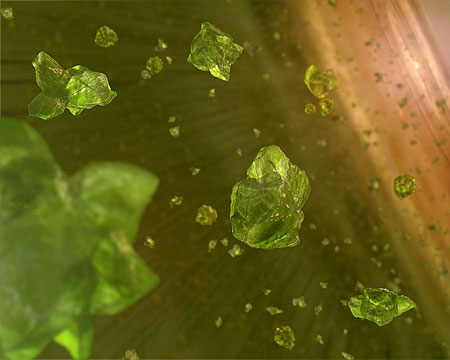When Stars Fail, Planets Might Still Succeed

Some potential stars just don't quite make it. They don't have enough mass to trigger the thermonuclear fusion that powers regular stars. They stall out, more massive than a planet but not as hot as a star.
Astronomers call these failed stars brown dwarfs. Theory suggests planets could form around them. One such setup has been found but not confirmed.
Now NASA's Spitzer Space Telescope has found what may be the first stages of planet formation around brown dwarfs.
Planet seeds
Small clumps of microscopic dust grains and tiny crystals were detected orbiting five brown dwarfs. The material has flattened into a thin disk, which is what astronomers believe occurs before planets form around regular stars like the Sun.
The material in the newfound disks is the very stuff of planet formation, according to leading theory. Its the same ingredients spotted around regular young stars in other studies.
The recipe has also been found in comets, which astronomers believe to be relatively pristine leftovers of the planet-formation process in our solar system.
Get the Space.com Newsletter
Breaking space news, the latest updates on rocket launches, skywatching events and more!
"We are learning that the first stages of planet formation are more robust than previously believed," said Dániel Apai, an astronomer at the University of Arizona and member of the NASA Astrobiology Institute.
The results are detailed in today's issue of the journal Science.
Strange worlds
A brown dwarf shines in the infrared but releases very little if any visible light. Brown dwarfs have also been found orbiting other stars and orbiting other brown dwarfs.
The brown dwarfs in the study are all about 520 light-years away, in the Chamaeleon constellation. They range in mass from 40 to 70 times the heft of Jupiter. They are young, at roughly 1 million to 3 million years old. Our Sun is 4.6 billion years old.
Planets around brown dwarfs would be dark and cold, so astronomers don't know if life could form on them.
Analysis of the Spitzer data shows that the dust particles have crystallized and are sticking together. One key ingredient found was the mineral olivine, the researchers said.
"We are seeing processed particles that are linking up and growing in size," said Ilaria Pascucci, also from the University of Arizona and a co-author of the study. "This is exciting because we weren't sure if the disks of such cool objects would behave the same way that stellar disks do."
- 'Super Earth' Discovered at Nearby Star
- New Neighbor May Be Closest Known Brown Dwarf
- Alien Worlds through Artist's Eyes
Join our Space Forums to keep talking space on the latest missions, night sky and more! And if you have a news tip, correction or comment, let us know at: community@space.com.

Rob has been producing internet content since the mid-1990s. He was a writer, editor and Director of Site Operations at Space.com starting in 1999. He served as Managing Editor of LiveScience since its launch in 2004. He then oversaw news operations for the Space.com's then-parent company TechMediaNetwork's growing suite of technology, science and business news sites. Prior to joining the company, Rob was an editor at The Star-Ledger in New Jersey. He has a journalism degree from Humboldt State University in California, is an author and also writes for Medium.









